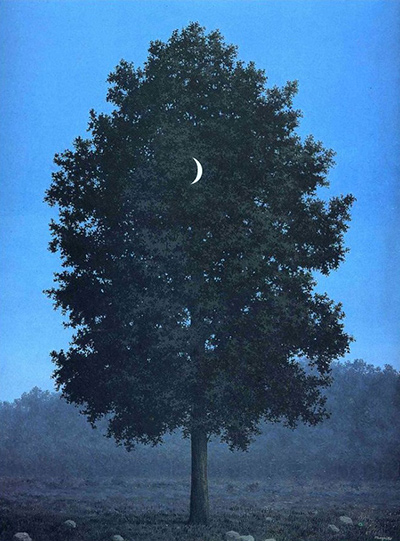René François Ghislain Magritte was a Belgian surrealist artist who died in August 1967 at the age of 69. Rene Magritte is well known in the world of arts for some amusing and witty paintings that he did during his career. Surrealism, of which he was a member, was a cultural outfit that started in the mid-1920’s.
Rene did a lot of paintings that featured certain elements of unexpected juxtapositions, surprise, as well as the use of non-sequiturs. One of his famous works was the Sixteenth Of September. This piece was done in the year 1956, and just as other pieces he had done, this one was an extraordinary one. Most of his paintings displayed a juxtaposition of normal items in a rather unusual context and therefore offering new meanings to the already known things. It was the custom of this Belgian surrealist artist to confound and surprise his viewers, and that’s exactly what he did with the Sixteenth Of September piece. In this piece of art, a slim waxing crescent moon is shown centered in front of a tree.
Depicting that the moon shown was that of 16th September 1956 would be wrong since the moon appeared much fuller on that particular night. Those who were used to Magritte’s arts were not surprised when they saw a superimposed crescent moon just in front of a beautiful tree. In fact, he termed this type of intentional juxtaposition of unsuited objects, like the one depicted in Sixteenth Of September as objective stimulus. While referring to this beautiful image done in 1956, Rene Magritte stated that he had painted the moon on a tree in the beautiful grey-blue colors associated with a typical evening. Another thing that most people did not know about the painter of Sixteenth Of September was that the titles of most of his works were arrived at after full completion of the work.
In the case of Sixteenth Of September, this beautiful title was an idea that was forwarded on by one of Rene’s friends, Louis Scutenaire, a surrealist poet. By showing the image of that unstable structure, the artist sought to not only subverts the general law of physics but also to put the perception of the viewer to a test. The image seems to be deeply rooted in a typical common culture. In this particular image, the moon is clearly depicted to have left its normal orbit and surprisingly attaches itself to a beautiful tree standing alone. The entire scene, however, appears as a matter-of-fact, thanks to this professional painter’s careful and dispassionate brushwork. He was also known as one artist who knew how to urge his viewers on matters of awareness. He used some of the best tactics in this game, with his favorite ones being shifts in gravity and size.
Looking carefully at the image, one will notice how the painter played with those two factors to come up with this beautiful, yet a very hard to understand the image. The foreground and background of the image have been carefully switched for a specific reason. Rene Magritte switched the foreground and the background to enable the viewers to see the tree is seen behind the moon as opposed to seeing the moon through this beautiful tree. This is how Rene Magritte had excelled in this game and could do certain things to his picture that others could not easily understand. This image of Sixteenth Of September also disturbs the notion of pictorial depth to certain instances. Checking the image carefully, there are certain few daubs of white pigment that have been used in the landscape to erase what can be referred to as deep space. The issue of scale is also another area that Rene Magritte focused on in most of his artworks. It is also evident in the Sixteenth Of September.
Against the sky, a waxing crescent just of the size shown in this picture would just make some sense. But looking at that image again, this crescent is superimposed on that beautiful tree, and it just appears just as if it was placed somewhere close to 230,000 miles far away. The medium of this nice artwork is a gouache over graphite on a piece of paper. This beautiful image was among the ones that were showcased at Dayton's Gallery in Minneapolis and sold to Russell Cowles. It was until the year 1980 that the painting was given to the MIA. Rene Magritte would later describe his paintings by referring to them as visible images that conceal absolutely nothing. He admits that the images like Sixteenth Of September indeed evoke mystery and would make anyone wonder the meaning behind them. This was a great work.




